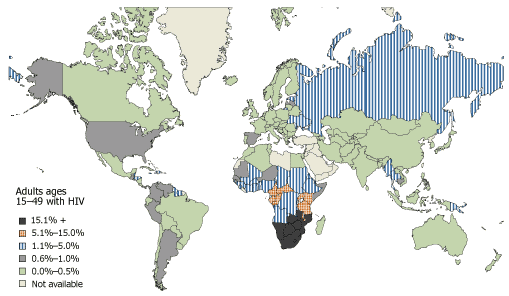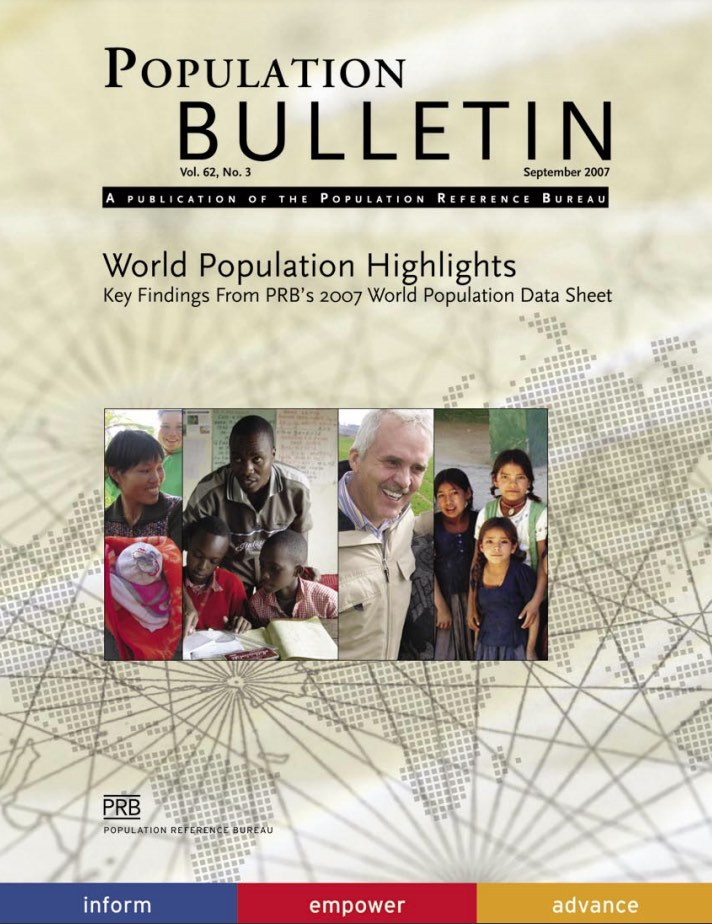
World Population Highlights 2007: HIV/AIDS
Date
August 16, 2007
Author
Focus Area
(September 2007) The AIDS epidemic is one of the most destructive health crises of modern times, ravaging families and communities around the world. By 2006, more than 25 million people had died and at least 35 million people were living with HIV. An estimated 4.3 million people were newly infected with HIV in 2006.
Nearly 63 percent of all people with HIV worldwide live in sub-Saharan Africa—25 million people. While southern Africa has been hardest hit, other regions also face serious AIDS epidemics. In recent years, nationally representative surveys have allowed researchers to lower previously published HIV prevalence estimates for some countries. But the number of people infected and the effects on families, communities, and countries are still staggering.
HIV Prevalence Is Highest in Southern Africa

Source: C. Haub, 2007 World Population Data Sheet.
HIV/AIDS Is More Common in Less Developed Regions.
| Percent of Population Ages 15–49 With HIV/AIDS, 2005/2006 | |
|---|---|
| WORLD | 0.9 |
| More developed regions | 0.5 |
| Less developed regions | 1.1 |
| Africa | 4.5 |
| North America | 0.6 |
| Latin America/Caribbean | 0.5 |
| Europe | 0.5 |
| Oceania | 0.4 |
| Asia | 0.2 |
Source: C. Haub, 2007 World Population Data Sheet.
Impact on Demographics and Health
Countries hard hit by the AIDS epidemic have seen mortality surge and life expectancy drop in the last decade. But the epidemic has not led to a decrease in population in sub-Saharan Africa, due to relatively high fertility. Even accounting for AIDS-related mortality, sub-Saharan Africa’s population is projected to grow from 788 million in 2007 to 1.7 billion in 2050.
AIDS takes a major toll on societies. It ranks fourth among the leading causes of death worldwide and first in sub-Saharan Africa. In 2006, UNAIDS estimated that 2.9 million adults and children died of AIDS and 2.1 million of them were in sub-Saharan Africa.
Effects on Mortality and Life Expectancy
People living with HIV and AIDS are prone to developing other illnesses and infections because their immune systems are suppressed. The AIDS epidemic has fueled a rise in tuberculosis wherever HIV prevalence is high. In sub-Saharan Africa, death rates among children under age 5 are substantially higher than they would be without HIV. Without lifesaving drugs, one-third of children who are born infected with HIV (transmitted through their mothers) die before their first birthday, and about 60 percent die by age 5.
The surge in AIDS deaths has also halted or reversed gains in life expectancy in many African countries. For example, in Lesotho, where an estimated one in every four adults was living with HIV/AIDS in 2005, life expectancy was nearly 60 years in 1995, but plummeted to 36 years by 2007, primarily due to AIDS-related deaths.
Prevention
As HIV continues to spread—in the absence of a vaccine or cure—prevention remains the key way to curb the epidemic. The most common mode of HIV transmission is sexual contact. Thus, effective prevention programs promote abstaining from sex, delaying the onset of sexual activity, staying with one mutually faithful partner, limiting the number of sexual partners, consistently and correctly using condoms, and counseling and testing for HIV. Preventing HIV transmission from mothers to their infants is also a way to save lives.
Measurement Challenges
Since 2001, a new source of data on HIV prevalence has become available for more countries: demographic and health surveys based on nationally representative samples. The Demographic and Health Survey (DHS) program, conducted by ORC Macro with national agencies, tests people for HIV. Most of the DHS surveys, along with the HIV/AIDS Indicator Surveys (AIS) completed so far, suggest HIV prevalence is likely lower than earlier estimates.
| % of HIV-Positive Adults | |||||
|---|---|---|---|---|---|
| UNAIDS | DHS/AIS | ||||
| Estimate at Time of DHS/AIS | Year | Estimate | Year | ||
| Burkina Faso | 4.2 | 2003 | 1.8 | 2003 | |
| Cote d’Ivoire | 7.1 | 2005 | 4.7 | 2005 | |
| Kenya | 15.0 | 2001 | 6.7 | 2003 | |
| Zambia | 21.5 | 2001 | 15.6 | 2001/2002 | |
In India, a nationally representative survey found that 0.36 percent of adults ages 15 to 49 were HIV positive in 2006, compared with a non-nationally representative UNAIDS estimate of 0.9 percent in 2005.
Case In Point.
AIDS-related deaths have dramatically cut life expectancy in the most affected countries and regions. In southern Africa, home to many of the worst affected countries, life expectancy dropped from 61 years of age to 49 over the last 20 years.
AIDS reshapes the distribution of deaths by age. From 1985 to 1990, deaths in eastern Africa were clustered among young children and older adults. Adults ages 20 to 49 accounted for 16 percent of all deaths. But by 2010, that share will most likely nearly double to 29 percent of all deaths. Such large surges in deaths deplete a country of residents in their prime productive years, creating the potential for severe shocks to the economy and society.
South Africa reflects many of the changes projected for populations severely affected by AIDS. By 2015, the adult population (ages 15 and older) is projected to be smaller by 6 million people (16 percent). Deaths of large numbers of women during their reproductive years and the lower survival prospects of infected children will reduce the size of the younger population as well. The total population in South Africa in 2015 is projected to be 50 million—or 15 percent lower than in a no-AIDS scenario.
Sources
Lori S. Ashford, How HIV and AIDS Affect Populations (Washington, DC: Population Reference Bureau, 2006).
Carl Haub, 2007 World Population Data Sheet (Washington, DC: Population Reference Bureau, 2007).
Carl Haub, “Improving Data Collection Efforts to Estimate HIV/AIDS,” accessed online at www.prb.org, on June 20, 2007.
Peter R. Lamptey, Jami L. Johnson, and Marya Khan, “The Global Challenge of HIV and AIDS,” Population Bulletin 61, no. 1 (2006).
UNAIDS, AIDS Epidemic Update: December 2006, accessed online at www.unaids.org, on June 28, 2007.
United Nations, World Population Prospects: The 2006 Revision (New York: United Nations, 2007).

 ">
">